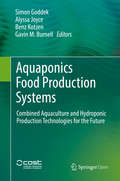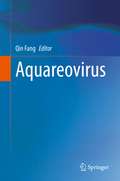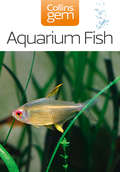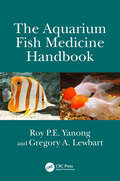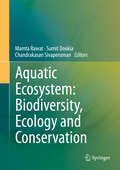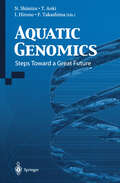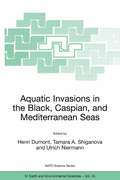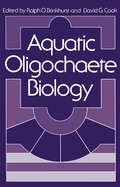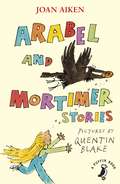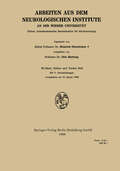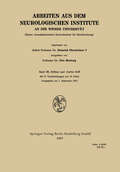- Table View
- List View
Aquaponics Food Production Systems: Combined Aquaculture and Hydroponic Production Technologies for the Future
by Simon Goddek Alyssa Joyce Benz Kotzen Gavin M. BurnellThis open access book, written by world experts in aquaponics and related technologies, provides the authoritative and comprehensive overview of the key aquaculture and hydroponic and other integrated systems, socio-economic and environmental aspects. Aquaponic systems, which combine aquaculture and vegetable food production offer alternative technology solutions for a world that is increasingly under stress through population growth, urbanisation, water shortages, land and soil degradation, environmental pollution, world hunger and climate change.
Aquareovirus
by Qin FangAquareoviruses cause infection in bony fish and shellfish and thus, constitute a significant threat to aquaculture industries worldwide. Aquareoviruses, belonging to the family Reoviridae, have genomes consisting of 11 segments of double-stranded RNA contained within a core (T = 1) surrounded by a double-layered icosahedral capsid with a T = 13 symmetry in general. These viruses not only physically resemble mammalian orthoreoviruses, but also show the highest amino acid identity. More than hundred aquareoviruses have been isolated from both saline water and freshwater origins; however, literary sources elucidating aquareovirus biology are very limited. Given the increasing pace of discovery, it is imperative to make a clear, systematic filing of key aspects of aquareoviruses. Therefore, the aim of writing this book is to provide insights into the molecular mechanisms of evolution, pathogenesis, and host response in aquareovirus infection. This book offers a state-of-the-art report on recent discoveries concerning the aquareovirus genome evolution, gene encoded protein functions, and pathogenesis by comparison with its sister genus Orthoreovirus, including avian and mammalian reoviruses. It mainly focuses on advances made over the past 30 years in research on the general and molecular biology, protein structure and function, infection and replication, epidemiology and diagnosis, immunological prevention and medical treatment, and host antiviral immunity against aquareovirus infection. This book will help curious graduate students or interested researchers acquire an overall picture of aquareovirus infection and pathogenesis, as well as yield benefits in fisheries to better prevent and control diseases caused by aquareovirus infection.
Aquarium Fish (Collins Gem)
by CollinsThis handy, pocket-sized guide is essential reading for anyone who owns, or is thinking of investing in, an aquarium. It’s packed with colour photographs and provides all the information you need in a concise and accessible format.
The Aquarium Fish Medicine Handbook
by Roy P.E. Yanong Gregory A. LewbartPracticing veterinarians, veterinary technicians, professional aquarists, fish researchers, and tropical fish hobbyists will find this thorough yet concise handbook a complete how-to guide for keeping fish under human care healthy and thriving. Whether you're new to fish medicine and husbandry or an expert in the field, there is valuable information within these pages for you. The book is arranged in a logical order so that readers can quickly and efficiently find the information they seek. The book is filled with valuable and applicable information on dozens of topics including how to manage aquatic life support systems for fish, history taking, natural history, anatomy, physiology, diagnostic techniques, anesthesia, analgesia, and surgery. Virtually all of the most important ornamental fish pathogens, including viruses, bacteria, fungi, and parasites, are described and richly illustrated. There are also sections on fish welfare and conservation.While there are many books on the market that explore the topics of ornamental fish health and care, none provide the amount of helpful information and resources in such a small, affordable package.
The Aquarium Fish Medicine Handbook
by Roy P.E. Yanong Gregory A. LewbartPracticing veterinarians, veterinary technicians, professional aquarists, fish researchers, and tropical fish hobbyists will find this thorough yet concise handbook a complete how-to guide for keeping fish under human care healthy and thriving. Whether you're new to fish medicine and husbandry or an expert in the field, there is valuable information within these pages for you. The book is arranged in a logical order so that readers can quickly and efficiently find the information they seek. The book is filled with valuable and applicable information on dozens of topics including how to manage aquatic life support systems for fish, history taking, natural history, anatomy, physiology, diagnostic techniques, anesthesia, analgesia, and surgery. Virtually all of the most important ornamental fish pathogens, including viruses, bacteria, fungi, and parasites, are described and richly illustrated. There are also sections on fish welfare and conservation.While there are many books on the market that explore the topics of ornamental fish health and care, none provide the amount of helpful information and resources in such a small, affordable package.
Aquatic Animal Nutrition: A Mechanistic Perspective from Individuals to Generations
by Christian E. SteinbergThis book is a unique cross fertilization of aquatic ecology and aquaculture. It shows how diets structure the digestive tract and its microbiota and, in turn, the microbiota influences life history traits of its host, including behavior. Short-term starvation can have beneficial effects on individuals themselves and succeeding generations which may acquire multiple stress resistances – a mechanism strengthening the persistence of populations. From terrestrial, but not yet from aquatic animals, it is understood that circadian the rhythmicity makes toxins or good food. On the long-term, the dietary basis impacts succeeding generations and can trigger a sympatric speciation by (epi)-genetics. This volume defines gaps in nutritional research and practice of farmed fishes and invertebrates by referring to knowledge from marine and freshwater biology. It also points out that dietary benefits and deficiencies have effects on several succeeding generations, indicating that well designed diets may have the potential to successfully improve broodstock and breeding effort.
Aquatic Animal Nutrition: Organic Macro- and Micro-Nutrients
by Christian E.W. SteinbergAs sequel to Aquatic Animal Nutrition – A Mechanistic Perspective from Individuals to Generations, the present treatise on organic macro- and micronutrients continues the unique cross fertilization of aquatic ecology/ecophysiology and aquaculture. This treatise considers proteins and their constituents, carbohydrates from mono- to polysaccharides, fatty acids from free acids to fat, and waxes. It becomes obvious that these organic nutrients are more than only simple fuel for the metabolism of animals; rather, their constituents have messenger and controlling function for the actual consuming individual and even for succeeding generations. This aspect will become particularly clear by putting the organisms under consideration back into their ecosystem with their interrelationships and interdependencies. Furthermore, micronutrients, such as vitamins and nucleotides as well as exogenous enzymes, are in the focus of this volume with known and still-to-be-discovered controlling physiological and biomolecular functions.Aquatic Animal Nutrition – Organic Macro and Micro Nutrients addresses several gaps in nutritional research and practice. One major gap is the lack of common research standards and protocols for nutritional studies so that virtually incomparable approaches have to be compared. This applies also to the studied animals, since most approaches disregard intraspecific variabilities and the existence of epimutations in farmed individuals. Furthermore, recalling the Mechanistic Perspective from Individuals to Generations, dietary benefits and deficiencies have effects on succeeding generations. In most studies, this long-term and sustainable aspect is overruled by pure short-term production aspects. By comparing nutritional behavior and success of fishes and invertebrates, Aquatic Animal Nutrition points out different metabolic pathways in these animal groups and discusses how, for instance, fishes would benefit when having some successful metabolic pathway of invertebrates. Application of novel genetic techniques will help turn this vision into reality. However, a widely missing link in the current nutritional research is epigenetics regarding transgenerational heritages of acquired morphological and physiological properties. To increase public acceptance, nutritional optimization of farmed animals based on this mechanism, rather than genetical engineering, appears promising.
Aquatic Birds in the Trophic Web of Lakes: Proceedings of a symposium held in Sackville, New Brunswick, Canada, in August 1991 (Developments in Hydrobiology #96)
by Joseph J. KerekesBirds are an integral part of most freshwater ecosystems (lakes, rivers, wetlands) but their role in the trophic dynamics of these water bodies has often been overlooked. As a conspicuous part of the biota of water bodies, aquatic birds are indicators of their trophic state both in terms of species composition (quality) as well as occupancy and breeding (quantity). Birds may also influence the trophic state of a water body by importing nutrients (.e.g. resident or migrating birds feeding on adjacent watersheds or the sea). Because of anthropogenic activities, predation or their mobility, birds may not utilize otherwise suitable aquatic habitat. These factors complicate the relationship between aquatic bird production and the trophic status of habitats. As a consequence, the role of aquatic birds in freshwater ecosystems has usually been ignored. This volume contains a wide range of papers selected from those presented at the symposium and reviewed.
Aquatic Ecosystem: Biodiversity, Ecology And Conservation
by Mamta Rawat Sumit Dookia Chandrakasan SivaperumanThis book brings together the latest information on the rapid advances and developments in the field of aquatic ecology. India is very rich in terms of biological diversity due to its wide range of habitats and climatic conditions. It is home to as much as 7 per cent of the world’s animal species, although it only accounts for about 2 per cent of the total landmass. The present work on biodiversity, ecology and conservation of aquatic resources represents original research in the field of aquatic biodiversity, wetland ecology and its applications with reference to the country’s aquatic resources. There are 19 chapters, each contributed by an expert in his/her particular field and offering novel approaches to various topics in the area of aquatic ecosystems.
Aquatic Genomics: Steps Toward a Great Future
by N. Shimizu T. Aoki I. Hirono F. TakashimaIn a scientific pursuit there is continual food for discovery and wonder. M. Shelley (1818) Genomic analysis of aquatic species has long been overshadowed by the superb activity of the human genome project. However, aquatic genomics is now in the limelight as evidenced by the recent accomplishment of fugu genome sequencing, which provided a significant foundation for comparative fish genomics. Undoubt edly, such progress will provide an exciting and unparalleled boost to our knowl edge of the genetics of aquatic species. Thus, aquatic genomics research has become a promising new research field with an impact on the fishery industry. It is notewor thy that the Food and Agriculture Organization (FAO) of the United Nations has projected that current global fisheries production will soon become insufficient to supply the increasing world population and that aquaculture has a great potential to fulfill that demand. This book, Aquatic Genomic. ~: Steps Toward a Great Future, was designed as a collection of advanced knowledge in aquatic genomics and biological sciences. It covers a variety of aquatic organisms including fish, crustaceans, and shellfish, and describes various advanced methodologies, including genome analysis, gene map ping, DNA markers, and EST analysis. Also included are discussions of many sub jects such as regulation of gene expression, stress and immune responses, sex differ entiation, hormonal control, and transgenic fishes.
Aquatic Insects: Behavior and Ecology
by Kleber Del-Claro Rhainer GuillermoThis book presents a broad view of the ecology and behavior of aquatic insects, raising awareness of this conspicuous and yet little known fauna that inhabits inland waterbodies such as rivers, lakes and streams, and is particularly abundant and diverse in tropical ecosystems. The chapters address topics such as distribution, dispersal, territoriality, mating behavior, parental care and the role of sensory systems in the response to external and internal cues. In the context of ecology, it discusses aquatic insects as bio indicators that may be used to assess environmental disturbances, either in protected or urban areas, and provides insights into how genetic connectivity can support the development of novel conservation strategies. It also explores how aquatic insects can inspire solutions for various problems faced by modern society, presenting examples in the fields of material science, optics, sensorics and robotics.
Aquatic Invasions in the Black, Caspian, and Mediterranean Seas (Nato Science Series: IV: #35)
by Henri Dumont Tamara A. Shiganova Ulrich NiermannThe Mediterranean, Black, and Caspian Seas, the rivers and canals that connect them, and the enormous volume of shipping in the region, represent a conduit for aquatic invasion, whose consequences are only now beginning to be understood. This book provides an up-to-date overview of jelly invasions in the Ponto-Caspian which have affected local ecosystems since the early 1980s, contrasting that with other biological invasions, in search of underlying principles.
Aquatic Mites from Genes to Communities
by Heather C. ProctorAlthough the ancestral home of chelicerates was the sea, the vast majority of modern species live on land. Most students of spiders and mites also restrict themselves to terrestrial habitats. However, a surprising number of mites (Arachnida: Acari) have returned to a watery existence. Approximately 7000 species from the Mesostigmata, Astigmata, Oribatida, and especially the Prostigmata, now live in marine and freshwater habitats. In Aquatic Mites, a dozen chapters explore the distribution, ecology, behavior, genetics, and evolution of the most diverse of these astonishing arachnids. The results of these studies raise as many interesting questions as they answer, and should provoke more investigations of the biology of freshwater and marine Acari.
Aquatic Oligochaete Biology
by Ralph O. BrinkhurstAfter some conversations with Professor Dr. H. Caspers and other participants at the triennial congress of the International Association of Theoretical and Applied Limnology (S. I. L. ) held in Copenhagen, Denmark (1977), the senior editor approached the international delegates at the business meeting for approval of the concept of holding the First International Symposium on Aquatic Oligochaete Biology at Sidney (near Victoria) British Columbia on May 1-4, 1979. The S. I. L. agreed to sponsor such a meeting, and this sponsorship in turn led to the provision of space and technical facilities at the Institute of Ocean Sciences Patricia Bay, the Pacific Regional headquarters of the Ocean and Aquatic Sciences component of the federal Fisheri~s and Oceans Department. The National Research Council of Canada provided travel support for a number of non-Canadian participants. Invitations were sent to as many active workers in the field as the senior editor could name, and in addition two representatives of closely allied fields were invited - Dr. V. Standen who works with closely related but terrestrial species, and Dr. J. Grassle who works with polychaetes but especially with Capitella capitata which is much like an oligochaete in some aspects of its biolog- so much so that the senior editor in his salad days succumbed to some ill-founded advice and described Capitella as a new marine tubificid! The addition of these "outside" influences prevented the group from making a number of unfounded assumptions during discussions, and provided valuable cross-linkages.
Aquatic Oligochaete Biology: Proceedings of the 4th International Symposium on Aquatic Oligochaete Biology (Developments in Hydrobiology #51)
by J. L. KasterProceedings of the 4th International Symposium on Aquatic Oligochaete Biology
Aquatic Oligochaete Biology V: Proceedings of the 5th Oligochaete Symposium, held in Tallinn, Estonia, 1991 (Developments in Hydrobiology #95)
by Trefor B. Reynoldson Kathryn A. CoatesThis book contains 36 of the papers presented at the meetings covering the many aspects of oligochaete biology from ecological through evolutionary studies, divided into the following sections: Systematics and Evolution Taxonomy and Geographic Distribution Distribution, Abundance and Habitat Types Ultrastructure Pollution Studies Population Dynamics The volume highlights the single largest contribution of Soviet oligochaete biology presented in English since 1980. Nine of the 36 papers in this collection are written by authors from the former U.S.S.R.
Aquatic Oligochaete Biology VI: Proceedings of the VI International Symposium on Aquatic Oligochaetes held in Strömstat, Sweden, September 5–10, 1994 (Developments in Hydrobiology #115)
by Kathryn A. Coates Trefor B. Reynoldson Thomas B. ReynoldsonRecent studies on diverse aspects of the biology of clitellate works (oligochaetes and leeches) are found in the Proceedings of the most recent International Symposium on Aquatic Oligochaete Biology - from development to population dynamics and from ultrastructure to evolution. The majority of the contributions, which have a very broad geographic scope, are investigations of the biology and ecology of oligochaete works in natural and polluted waters.
Aquatic Oligochaetes: Proceedings of the 7th International Symposium on Aquatic Oligochaetes held in Presque Isle, Maine, USA, 18–22 August 1997 (Developments in Hydrobiology #139)
by K. A. Coates T. B. Reynoldson B. M. HealyThe book contains papers on the biology of aquatic oligochaetes and some related groups. They cover a wide range of topics including phylogeny, taxonomy, geographic distribution, freshwater and marine ecology, population dynamics, histology and ultrastructure, physiology and behaviour. The wide scope is in line with recent trends in annelid research with less emphasis on pollution studies and faunistics and a renewed interest in experimental biology using new techniques.
Aquatic Sciences in the Tropics: Plankton, Animal Community and Productivity
by B. B. JanaThe anatomy of water, water as a substance, water as a medium, the principles of the hydrologic cycle, the economics of water, and challenges are all covered in the first chapter of this book. The horizon of the tropical world, the environment, particularly the tropical environment, aquatic biome, tropical aquatic bionetwork, concept of biosphere, and tropical limnology are all covered in the second chapter. The third chapter covers the following topics: the origins of lakes, general lake classification, tropical lakes, lake morphometry, morpho-edaphic index, trophic status index of lakes, wetlands, and mangroves in tropical regions. The lotic environment is the main topic of the fourth chapter, which also covers the idea of stream order, the differences between rivers and streams, the river continuum, physical, chemical, and biological characteristics, and adaptations of fish found in hill streams. Chapter five covers the prokaryota, cyanobacteria, freshwater biota, and water-adapted organisms. The sixth chapter focuses on the algal communities Xanthophyceae, Euglenophyceae, Bacillariophyceae, Chrysophyceae, Phaeophyceae (brown algae), and Chlorophyceae. The seventh and last chapter covers the following topics: Protozoa, Porifera, Rotifera, Coelenterata, Annelida, Arthropoda, Crustacea, Aquatic Insects, Mollusca, Echinodermata, and Brachiopodaa.
Aquatic Sciences in the Tropics: Plankton, Animal Community and Productivity
by B. B. JanaThe anatomy of water, water as a substance, water as a medium, the principles of the hydrologic cycle, the economics of water, and challenges are all covered in the first chapter of this book. The horizon of the tropical world, the environment, particularly the tropical environment, aquatic biome, tropical aquatic bionetwork, concept of biosphere, and tropical limnology are all covered in the second chapter. The third chapter covers the following topics: the origins of lakes, general lake classification, tropical lakes, lake morphometry, morpho-edaphic index, trophic status index of lakes, wetlands, and mangroves in tropical regions. The lotic environment is the main topic of the fourth chapter, which also covers the idea of stream order, the differences between rivers and streams, the river continuum, physical, chemical, and biological characteristics, and adaptations of fish found in hill streams. Chapter five covers the prokaryota, cyanobacteria, freshwater biota, and water-adapted organisms. The sixth chapter focuses on the algal communities Xanthophyceae, Euglenophyceae, Bacillariophyceae, Chrysophyceae, Phaeophyceae (brown algae), and Chlorophyceae. The seventh and last chapter covers the following topics: Protozoa, Porifera, Rotifera, Coelenterata, Annelida, Arthropoda, Crustacea, Aquatic Insects, Mollusca, Echinodermata, and Brachiopodaa.
Aquatic Telemetry: Proceedings of the Fourth Conference on Fish Telemetry in Europe (Developments in Hydrobiology #165)
by Eva B. Thorstad, Ian A. Fleming and Tor Fredrik NæsjeThis volume provides a selection of the most significant papers presented at the Fourth Conference on Fish Telemetry in Europe, in Trondheim, Norway, in 2001. Papers are focused on migratory patterns and habitat utilisation, social behaviour, physiological ecology, fisheries management, effects of human impact on fish populations, aquaculture and methodology, and new technology. This book is aimed at scientists and engineers actively involved in aquatic telemetry projects, aquatic biologists (marine and freshwater), fisheries biologists and managers.
The Aquatic World of Penguins: Biology of Fish-Birds (Fascinating Life Sciences)
by David G Ainley Rory P WilsonCenturies ago, when penguins were first encountered by European explorers, they were not thought to be birds but rather a fish-like relative. Subsequent accumulation of knowledge has shown penguins to be an avian species with unrivaled aquatic attributes, owing to a number of evolutionary adaptations: shape change, low drag, ability to regulate buoyancy, and extraordinary surface compliancy from their featheration. They are indeed the most extremely specialized diving bird, having given up flight (which otherwise is hugely advantageous) to the benefit of underwater prowess (such as speed, maneuverability and an ability to exploit an extraordinary range of depths). This flightlessness, however, also comes with costs that are substantial for a seabird (such as the inability to cover large distances quickly in reaction to ephemeral prey); and the energy needed to cope with moving through an aqueous environment, which is more resistant than air. For penguins, the high energetic costs in exploiting the ocean environment thus makes them especially sensitive to changes in food availability or their access to their prey. While a number of “penguin books” cover the natural history, mainly of breeding aspects, few address in much detail the incredible aquatic nature of these creatures. A huge amount of information has been amassed over recent past decades thanks to dramatic advances in microelectronics, bio-logging and maturation of some long-term studies of penguin life history. This work represents an integration of all these data with charts, maps and graphs, along with richly illustrated photos by experts in the field.
Arabel and Mortimer Stories (A Puffin Book)
by Joan AikenArabel and her notorious raven Mortimer make a welcome return to Puffin Books!When Arabel's father, Ebenezer Jones, drives his taxi home late one night he comes across 'a large black bird, with a hairy fringe around its beak.' He takes it home and from that moment on, life is never the same again for the Jones family. Arabel's raven is called Mortimer - and he's one in amillion. 'Nevermore!' he cries when astonished or upset, 'Down the hatch' he thinks before gobbling bowler hats, stairs, telephones. He dislikes flying except in emergencies, and with disaster-prone Mortimer around there are plenty of those. There are six hilarious escapades in this collection, brought to life by Quentin Blake's wonderfully animated illustrations.
Arbeiten aus dem Neurologischen Institute an der Wiener Universität: Österr. Interakademisches Zentralinstitut für Hirnforschung
by Heinrich Obersteiner Otto MarburgDieser Buchtitel ist Teil des Digitalisierungsprojekts Springer Book Archives mit Publikationen, die seit den Anfängen des Verlags von 1842 erschienen sind. Der Verlag stellt mit diesem Archiv Quellen für die historische wie auch die disziplingeschichtliche Forschung zur Verfügung, die jeweils im historischen Kontext betrachtet werden müssen. Dieser Titel erschien in der Zeit vor 1945 und wird daher in seiner zeittypischen politisch-ideologischen Ausrichtung vom Verlag nicht beworben.
Arbeiten aus dem Neurologischen Institute an der Wiener Universität: Österr. Interakademisches Zentralinstitut für Hirnforschung
by Heinrich Obersteiner Otto MarburgDieser Buchtitel ist Teil des Digitalisierungsprojekts Springer Book Archives mit Publikationen, die seit den Anfängen des Verlags von 1842 erschienen sind. Der Verlag stellt mit diesem Archiv Quellen für die historische wie auch die disziplingeschichtliche Forschung zur Verfügung, die jeweils im historischen Kontext betrachtet werden müssen. Dieser Titel erschien in der Zeit vor 1945 und wird daher in seiner zeittypischen politisch-ideologischen Ausrichtung vom Verlag nicht beworben.
